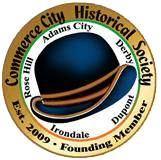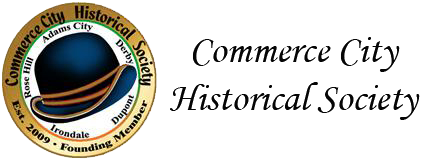Commerce City History
In the mid-1800s
Many trading forts were built along the Platte River. In 1832, Louis Vasquez built a trading post on the east banks of Cannonball Creek. Today this stream is known as Clear Creek. Vasquez’s Fort Convenience was located in the area of the present-day Adams County Social Services Building at 4200 E. 72nd Avenue.
The first settlers came into the area that now comprises Commerce City around 1850. Some of them arrived in covered wagons. Nine Mile House, located in the Dupont area, was one of the stage stations on the Overland Route. It was situated approximately where 88th Avenue and Interstate 76 are today. The Homestead Act of 1862 allowed settlers 160 acres of free land for farms and ranches. In 1867, Danish settlers along Sand Creek began hog farming. Water was supplied from local wells and from ditches that ran from the South Platte River.
Local schools began operating in 1871
As a one-room schoolhouse. Riverside Cemetery was founded in 1876 and the Colorado State Legislature created the office of “Fish Commissioner.” In November 1881, construction began on a new state fish hatchery near Dupont. The hatchery was rebuilt in 1889 and again in 1922 and closed in 1963.
In 1973, the Division of Wildlife remodeled the old hatchery structure to become a Hunter Safety Rifle Range. The buildings are located on 88th Avenue west of Interstate 76. In 2013, the flood destroyed the main fish hatchery building and it was demolished soon after.
Derby
Has been a community for more than a century but has never been officially recognized as a town or a city by the State of Colorado. As early as 1887, records state, Derby was a Burlington Northern Railroad station. The towns of Derby and Irondale were laid out in 1889.
Irondale was first settled in 1889, named after a foundry that was opened that year. It was incorporated as the Town of Irondale in 1924.
In 1926, Charles Black was elected mayor. Six trustees were also elected; Nettie Bruce, E. Sebastiana, Pete Palombo, Carl Faller, A. D’Andrea and M. Salmonese. The town was unincorporated in the 1930s due to increasing vacancy but remained a community.
Rose Hill Cemetery
Was established in 1892 by the United Hebrew Cemetery Association. The current Denver Botanical Gardens was a cemetery in 1892, and the Jewish graves were moved to Rose Hill Cemetery and other cemeteries throughout the city. The area was an open plain.
Old Arapahoe County extended all the way to the Kansas border and included the present-day city of Commerce City until Adams County was created in 1902. New schools were added to the area in 1899 and later in 1907.
Adams City was laid out in 1902 with developers hoping the county seat would be established there. However, Brighton was elected county seat on November 8, 1904, with 1,103 votes to Adams City’s 719 votes. Adams City never became a town and was vacated by 1922.
Rose Hill Grange
Many granges were established throughout the area, such as Henderson Grange (1890), Riverdale Grange (1910) and Rose Hill Grange (1915). In 1912, land was donated by John Reither to build Longbranch School.
There were three schools in the area that would become the Rocky Mountain Arsenal: Longbranch, Avoca Valley and Rose Hill schools.
In the mid-1920s
The first telephone company in the Adams County area was located in a home close to the old Hazeltine School. A fire burned the home, and the telephone company was moved to the corner of 72nd Avenue and Highway 85. In 1947, the phone exchange moved to 72nd Avenue, where the current AT&T building is located. The phone number prefix started with Atlas-8.
Until the late 1920s, the area was mainly a farming community where livestock, truck gardens and wheat fields flourished. Between 1923 and 1954, many dairies were located in the area, such as IXL Dairy, Model Dairy, Johnson Dairy, Harmony Dairy, Garden Farm, Starlight dairy, Morning Sun and Oak Leaf Dairy.
Industry moved into the area and refineries were established in the 1930s. At least 14 fish hatcheries located along the Platte River raised trout. Families that established the trout farms were the Hutchings, Fadens, Petersons, Kinneys, Manns, Miners, Otto Hutchinsons, and more. Grain elevators were built in 1937 by Oscar Mallo. the Hungarian Flour Company began operations in 1938.
The 88th and 64th Avenue
Some of the first roads to be built in the area were Irondale Road, now known as 88th Avenue, and Model Road, known today as 64th Avenue. Both of these roads went through Commerce City and extended east to where Denver International Airport is located.
These roads were closed off when the Rocky Mountain Arsenal came into existence. The Box Elder community was located on the land that now occupies Denver International Airport.
The Rocky Mountain Arsenal
Was founded in 1942, east of the growing community, in support of World War II. The South Adams County Volunteer Fire Department was founded in 1942 and Adams City was beginning to redevelop with new houses being built.
The Adams Heights subdivision was established in 1946. In 1946-47, Adams County School District 14 was formed from surrounding schools, with the first official class from Adams City High School graduating in 1949.
The football field
Was dedicated to Ed Krogh in October 1948. The fieldhouse was dedicated to Al Krogh, Ed’s son, in 1961.
New roads were being built in the area and some of the major ones were Highway 6 & 85 in 1948 and Highway 2 in the early 1950s. In 1950, the Commerce City Police Department named its first police chief, Edward A. Marzano.
The South Adams County Water and Sanitation District
Was formed in 1951 at the same time Denver was considering annexing the area. A plan to incorporate all of southern Adams County was developed. On July 8, 1952, a group of about 300 residents voted for incorporation of Commerce Town, comprising neighborhoods in southern Adams County such as Rose Hill, Adams City, Dupont and Irondale. Alfred Krogh was elected mayor along with six trustees: Sam Amato, Castor Hansen, John Juhl, John Kemp, Carl Lundgren and Paskey Teto.
In South Adams County, 15 of the 19 hog ranches were in the new Commerce Town area. Industries in the 1950s included six oil refineries, tow grain elevators and a dozen other major manufacturing and freight-hauling businesses. Several other businesses were established in the Derby area such as Latorin’s, Lucas Furniture, Ben Franklin, Hi-Lo Market, Wolf’s, Derby Beauty Shop, Derby Lanes, Heiny’s Shoe Service and Wohler’s Shoe Store.
In 1958, the Rainbow Bread Company was established. In 1965, the banks of Sand Creek and the South Platte River overflowed and caused extensive damage, resulting in Interstate 270 being built.
Commerce Town annexed part of Derby
In 1962, increasing the population fourfold. This was enough for the town to gain status as a city. The name was duly changed to Commerce City.
A new city hall was completed in 1967. It housed the first city library — the result of efforts by Mayor Leroy Fields and resident Charlene Jaramillo. Commerce City staffed the library and the Adams County Public Library supplied books and shelving. Lou Jaramillo and Marge Christiansen (the first woman on the Commerce City city council) directed landscaping efforts.
In 1967, the first park to be built in Commerce City was Gifford Park, located at 6120 Monaco St.
In the 1970s
Many parks were established within the city: City Park (1971), at 6015 Forest Drive; Veteran’s Memorial Park (1971), at 6150 Parkway Drive; Fairfax Park (1973), at 6850 Fairfax Drive; Monaco Park (1973), at 5790 Monaco Street; Olive Park (1974), at 6325 Olive Street; and Freedom Park (1974), at 6270 Oneida Street. A new library branch opened in Commerce City in 1977 at 7185 Monaco Street.
More parks were built in the 1980s, which included Adams Heights Park at 6625 Brighton Road; Derby Park at 7305 Monaco Street; Los Valientes Park at 7300 Magnolia Street; and Monaco Vista at 6250 Monaco Street.
Commerce City is the location of the last drive-in theater in the Denver metro-area, the 88th Avenue Drive-In, built in the mid-1970s and located at 8780 Rosemary Street. The first fast-food chain to build in Commerce City was McDonald’s, which opened a restaurant on September 22, 1980. In the 1980s, the city and the water department were in negotiations over the contamination issues at the Rocky Mountain Arsenal. These negotiations lasted for many years and involved many agencies.
In 1987
The Adams County voters approved to allow Denver to annex lands from unincorporated Adams County to build Denver International Airport, which opened in 1995. Although The Almanac and Sentinel reported on local issues, residents Norm and Janet Union established the Commerce City Beacon in 1988. The paper closed in March 2009. The Buffalo Run Golf Course was established in 1996.
In 1999, Larry Ford, the South Adams County Water and Sanitation District manager, and Bob Gehler, the city attorney, negotiated agreements with water and sewer for the development in the north areas. On April 6, 1999, the residents voted on an initiative not to restrict growth in the northern areas, which allowed the city to double in population and provided great potential for residential, retail and commercial development. As a result of this election, one of the first housing developments to be built was the Eagle Creek subdivision at 96th Avenue and Highway 2 in 1999. River Run followed this at 112th Avenue and Peoria Street. In 2002, Belle Creek was established and in 2003 Reunion and Fronterra were established along with many others.
Pioneer Park and River Run Park
Were two of the most recent parks built in 2004. Pioneer Park has three ballfields that were completed in phase one and batting cages, a skate park, bike hills and another ballfield when phase two finished in 2008. In 2005, the Prairie Gateway was formed.
On April 3, 2007, the citizens of Commerce City overwhelmingly voted to retain their city’s name in the city election and the new city hall complex, a world-class soccer stadium and the new Quebec Parkway were opened. In 2008 the beloved Adams City High School was closed and demolished in 2012. In 2009, a new state-of-the-art high school to replace the former ACHS opened at 7200 Quebec Parkway.
At the close of the first decade of the 21st century
More than 40,000 residents live in Commerce City’s 41-square-miles.
In 2013, the city residents voted in favor of 2K 1% Sales Tax which contributed to a new outdoor recreation pool (Paradice Island), 3 new parks, widening of Tower Road, a new recreation center (Bison Ridge) and the remodeling of the current recreation center and name change (Eagle Pointe).
In 2019, the city has over 55,000 residents.
After the city purchased four homes located behind the recreation center, the homes were demolished, and the area was cleared for a larger park. Commerce City Park and the Veteran’s Park became one park and was redeveloped, reopening in August 2020 as Veteran’s Park. In October 2020, the dog track area started redevelopment called “My Greyhound Park.”

